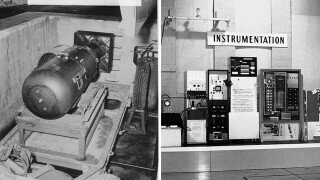How 'The Manhattan Project' Directly Led To Video Games

The Manhattan Project will go down in history as one of the most influential meetings of the minds of all time. The results were certainly world-altering, and those involved went on to lead unusual lives. J. Robert Oppenheimer went on to lobby against nuclear proliferation at the highest levels, and became embroiled in scandal during the Second Red Scare. Enrico Fermi came up with his famous paradox and laid the groundwork for the discovery of quarks. Richard Feynman … uh … played bongos or something, I dunno; what am I, an Oscar-bait biopic?
Today though, we’re not concerned with the lives of those celebrated names, but with one of their often overlooked peers. I speak, of course, about William Higinbotham. Any name that starts with Hig and ends with Ham is destined for greatness, and our William lives up to the hype. Sure, on the Manhattan Project he didn’t do much- just lead the electronics team that worked on the first atomic bomb. A cute side project, for sure, and integral to the success of the bomb, but compared to creating video games it’s pretty small potatoes. I mean, how many A-bombs do you have in your apartment?

After working on the world’s first nukes, Higinbotham did what everyone at Los Alamos did in those times and devoted himself to nuclear non-proliferation. Hypocritically telling people not to make nukes is noble work to be sure, but it doesn’t exactly pay the rent, so Higinbotham took a position at Brookhaven National Laboratory.
Don't Miss
Every year Brookhaven National Laboratory would hold a public exhibition. Why would a nuclear and high-energy laboratory have a public exhibition? Because the '50s were insane. During this public exhibition, there would be three days of visitors. One day for the general public, when everyone could come, one day for college students, which seems sensible, and one day for high schoolers, which is how we get Spider-Men.
11 years into being the Head of the Instrumentation Division at Brookhaven, William Higinbotham wanted to make something to entertain people who stopped by the Lab. So he created Tennis for Two, now believed to be the world’s first video game.
The screen for Tennis for Two wasn’t LCD or even a CRTV- it was played on an oscilloscope. An oscilloscope hooked up to the original Atari Missile Comand, by which I of course mean a computer designed to calculate ballistic missile trajectories. So Higinbotham took a computer meant to help track missiles, hooked it up to radar, and made tennis. The controllers were something he rigged together leading up to the exhibition, each sporting a single button to hit the tennis ball, and a dial to set the angle that you’d hit it at. All of this came together and looked like absolute garbage, as you can see here.
Kotaku gave it a 9/10 and called it Game of the Year.
From a modern perspective, it’s lacking a handful of things: a display for the score, customizable characters, or fun. But this was the best video game anyone at the exhibition had ever played (obviously) and hundreds of people waited hours for their turn. The game was so successful that Higinbotham ended up expanding it for the next year’s exhibition, creating a larger display and allowing you to play tennis on Jupiter, the Moon, but, sadly, not Uranus.
After its second year of exhibition, Tennis for Two was dismantled. Higinbotham always preferred his nuclear non-proliferation work to being “the Grandfather of Video Games,” but his legacy may end up split. Regardless of what he winds up being known for, I’m just glad there’s a direct line of consequence between creating the first nuclear weapon and the invention of video games.
Top Image: US Government, US Government